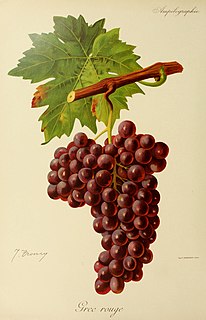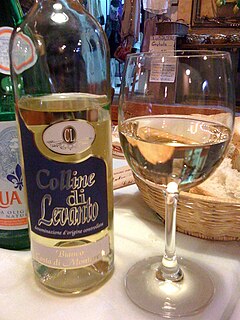
Dolcetto is a black Italian wine grape variety widely grown in the Piedmont region of northwest Italy. The Italian word dolcetto means "little sweet one", but it is not certain that the name originally carried any reference to the grape’s sugar levels: it is possible that it derives from the name of the hills where the vine is cultivated. In any case the wines produced are nearly always dry. They can be tannic and fruity with moderate, or decidedly low, levels of acidity and are typically meant to be consumed within a few years after release.

Italian wine is produced in every region of Italy. Italy is the world's largest producer of wine, with an area of 702,000 hectares under vineyard cultivation, and contributing a 2013–2017 annual average of 48.3 million hl of wine. In 2018 Italy accounted for 19 per cent of global production, ahead of France and Spain. Italian wine is both exported around the world and popular domestically among Italians, who consume an average of 42 litres per capita, ranking fifth in world wine consumption.

Barbaroux is a pink-skinned French wine grape variety grown in southeastern France. It is a permitted variety in the appellation d'origine contrôlée wine of Cassis in Provence as well as in the Ajaccio region of Corsica. While it is sometimes known under the synonym "Barbarossa", DNA profiling has shown the Barbaroux grown in Provence is distinct from the Barbarossa vines grown in Liguria and Piedmont and is likely unrelated to all Italian Barbaross vines. There is also debate among ampelographers about whether the Barbaroux vines in Provence and Corsica are the same grape or separate Vitis vinifera varieties.

Vermentino is a light-skinned wine grape variety, primarily found in Italian wine. It is widely planted in both Sardinia and Liguria, to some extent in Corsica, in Piedmont under the name Favorita, and in increasing amounts in Languedoc-Roussillon. The leaves are dark green and pentagonal. The grapes are amber-yellow and hang in pyramidal bunches. The vines are often grown on slopes facing the sea where they can benefit from the additional reflected light. The Vitis International Variety Catalogue now gives Italy as its origin.

Black Muscat is a red Vitis vinifera grape variety derived from the crossing of the Schiava Grossa and Muscat of Alexandria by Seward Snow, Head Gardener to Earl de Grey at Wrest Park, Bedfordshire UK in 1850, according to the Vitis International Variety Catalogue. It is known under a variety of local names such as Golden Hamburg, and Black Hamburg in the US; Muscat de Hambourg in France; Moscato di Amburgo in Italy; and Muscat Gamburgskiy in Russia and former Soviet Union countries. Confusingly, Black Hamburg is also used as a synonym for its maternal parent. It is commonly produced as table wine but in California's Central Valley it has been used in the production of dessert wine. As a dessert wine it can be highly aromatic with a rich coloring. In the US it is grown in wine appellations in California, Virginia, Oregon, Texas, and Washington. In Canada, it is also found on Vancouver Island.
Tibouren or Rossese di Dolceacqua is a red French wine grape variety that is primarily grown in Provence and Liguria but originated in Greece and possibly even the Middle East. Intensely aromatic, with an earthy bouquet that wine expert Jancis Robinson describes as garrigue, Tibouren is often used in the production of rosés.

Piemonte wine is the range of Italian wines made in the region of Piedmont in the northwestern corner of Italy. The best-known wines from the region include Barolo and Barbaresco. They are made from the Nebbiolo grape. These wines are ideal for storage and a well-aged Barolo for instance may leave a feeling of drinking velvet because the tannins are polished and integrated more and more into the wine. As the wine matures the colour becomes more brownish and rust-red.

Arneis is a white Italian wine grape variety originating from Piedmont, Italy. It is most commonly found in the hills of the Roero, northwest of Alba, where it is part of the white Denominazione di Origine Controllata e Garantita (DOCG) wines of Roero. It can also be used to produce DOC wines in Langhe. Arneis is so called because it is regarded as a somewhat difficult variety to grow. It is a crisp and floral varietal, and has been grown for centuries in the region. The white wines made from the Arneis grape tend to be dry and full bodied with notes of pears and apricots.
Barbarossa is the name of several red/pink colored Italian wine grape varieties. At one point the French wine grape Barbaroux was thought to also be a Barbarossa grape but DNA evidence published in 2009 confirmed that the French Barbaroux grown in Provence was a separate variety distinct from, at least, the Barbarossa grapes grown in Piedmont and Liguria. Further research is still being done map out the exact relation among all the Barbarossa varieties in Italy and with the Barbaroux grape grown in Corsica.
Favorita is a white Italian wine grape grown primarily in the Piedmont region. It is most widely planted on the left bank of the Tanaro river in the Roero district near Alba, though some plantings exist on the right bank of the Tanaro in the Langhe hills. Recent DNA profiling shows that Favorita is related to the Liguria grapes Pigato and Vermentino, which may support the theory that the grape originated there. Since the late 20th century, plantings of Favorita have been on the decline as Chardonnay and Arneis have increased in popularity among producers on the right and left bank of the Tanaro respectively. Featuring larger berry sizes than most wine grapes, Favorita has been a popular table grape in Piedmont.

Albarola is a white Italian wine grape variety grown in the northwest Italy. It is most commonly found in the Liguria region where producers in the Cinqueterre Denominazione di origine controllata (DOC) use it as a blending component. Wine expert Jancis Robinson describes the wine made from Albarola as fairly "neutral" in profile. Outside of Liguria, the grape was historically grown in Sicily but for most of the 20th century has been declining in plantings along with other ancient Sicilian varieties like Albanello, Damaschino, Minella bianca and Montonico bianco.
Bosco is a white Italian wine grape variety that is grown predominantly in the Liguria region of northwest Italy. It is a permitted variety in the Denominazione di origine controllata (DOC) wine of Cinque Terre where it is often the primary component of the blend. In winemaking, care must be taken in handling due to Bosco's propensity to oxidize easily, creating potential wine faults.

Liguria is an Italian wine region located in the northwest region of Italy along the Italian Riviera. It is bordered by the Piedmont wine region to the north, the Alps and French wine region of Provence to the west, the Apennine Mountains and the Emilia-Romagna wine region to the east with a small border shared with Tuscany in the south-east along the Ligurian sea.
Pollera nera is a red Italian wine grape variety that is grown primarily in the Liguria wine region and northwest Tuscany. Ampelographers believe that the vine has a very long winemaking history but it is rarely seen today. It is believed to have been descended from the Chianti wine grape Mammolo and the Corsican wine grape Sciacarello which would make it a half-sibling of Colombana nera.
Wine Grapes - A complete guide to 1,368 vine varieties, including their origins and flavours is a reference book about varieties of wine grapes. The book covers all grape varieties that were known to produce commercial quantities of wine at the time of writing, which meant 1,368 of the known 10,000 varieties. It is written by British Masters of Wine Jancis Robinson and Julia Harding in collaboration with Swiss grape geneticist Dr. José Vouillamoz.
Bracciola nera is a red Italian wine grape variety that is primarily found in the Liguria and Toscana wine regions of western Italy. The only Denominazione di origine controllata (DOC) that Bracciola nera plays a significant role is in the Colli di Luni DOC of Ligura where the grape is permitted to be blended with Sangiovese, Canaiolo, Pollera nera, Ciliegiolo, Vermentino nero and other varieties. A late-ripening variety, Bracciola nera usually contributes acidity to blends.

Vermentino nero is a red Italian wine grape variety that is predominantly grown in province of Massa-Carrara in Tuscany. After World War II, the vine was almost lost to extinction until Podere Scurtarola, a producer from Massa, began replanting old vineyards with the grape. By 2000, there were 199 hectares of Vermentino nero growing in Italy with the grape authorized for production in the Denominazione di origine controllata (DOC) wines of Candia dei Colli Apuani and Colline Lucchesi.
Besgano bianco is a white Italian wine grape variety that was historically used in the production of the dessert wine Vin Santo, blended with Malvasia Bianca Lunga and Verdea, but today is rarely planted and is more often used for table grape production than winemaking. The grape is also known as Colombana bianca but it is not a color mutation of the Tuscan and Emilia-Romagna wine grape Colombana nera.

Luglienga is a white Italian wine and table grape variety that is grown across Europe. The grape has a long history of use, dating back to at least the 14th century in Piedmont but is today most seen a table grape that is occasionally used for home winemaking.
Barsaglina is a red Italian wine grape variety that is grown in Tuscany and Liguria where it most often used to add color and tannins to blends. Some ampelographers speculate that grape may be related to Sangiovese due to morphological similarities. Barsaglina was near extinction until a Tuscan wine producer, Paolo Storchi, help revive the variety by making it a significant component of his red Indicazione Geografica Tipica (IGT) Toscana blend. The grape is also permitted to be used in the Denominazione di Origine Controllata (DOC) wines of Colli di Luni.











